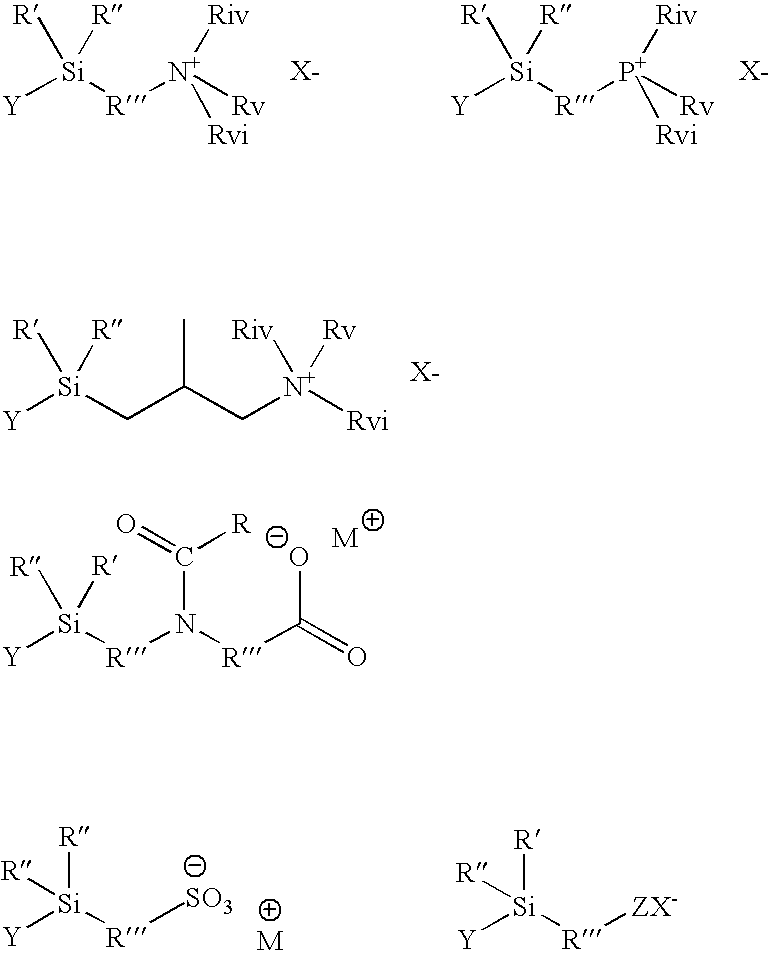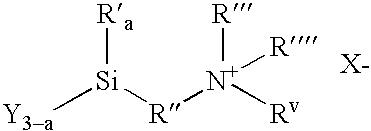Organosilicon Compounds
- Summary
- Abstract
- Description
- Claims
- Application Information
AI Technical Summary
Benefits of technology
Problems solved by technology
Method used
Image
Examples
example 1
3-(trimethoxysilyl)propyloctadecyldimethyl ammonium chloride in Ethylene glycol (hereinafter “Product II”)
[0034] A two liter, three-necked flask equipped with a condenser, stirrer, thermometer and a distillation head, was charged with 360 grams (six moles) of ethylene glycol. Next, 315 grams of a 70% solution of methanol containing 3-(trimethoxysilyl)propyloctadecyl-dimethyl ammonium chloride (hereinafter “Product I”) was added to the flask. The mixture was slowly heated under vacuum to 80° C. and free methanol 80 grams was distilled. The resulting composition was Product II.
example 2
3-[(2-hydroxyethoxy)dimethoxysilyl]propyldimethyloctadecyl ammonium chloride (hereinafter “Product III”)
[0035] The product solution (i.e. Product II) from example 1 was further heated to 120° C. under vacuum. The reaction was allowed to continue. The transesterification resulted in methanol liberation which was removed and condensed. After 16 grams of methanol (0.5 mole) was collected, vacuum was released and cooling was applied. The average structure of the components of the crude product mixture in ethylene glycol was (OCH3)2(OCH2CH2OH)SiCH2CH2CH2N+(CH3)2(C18H37)Cl−, namely 3-[(2-hydroxyethoxy)dimethoxysilyl]propyldimethyloctadecyl ammonium chloride (i.e. Product III).
example 3
Flash Point Evaluation
[0036] Products I, II and III were each subjected to a flash point test. The results are summarized in Table-1. Each product was then heated to 80° C. for 4 days to simulate long storage life and subjected to a second flash point determination. The results are summarized in Table-1. The data provided in Table-1 demonstrates that Product III, namely the transesterified orgaonsilicon, not only exhibited a higher flashpoint than the comparative products but also did not exhibit any reduction in flash point upon aging at 80° C. for four days.
TABLE 1SampleFlash Point* (° C.)Flash Point (° C.)after Aging*Product I1515Product II10525Product III105105
*Flash Points measured using Pensky-Martin Closed-cup
PUM
 Login to View More
Login to View More Abstract
Description
Claims
Application Information
 Login to View More
Login to View More - R&D
- Intellectual Property
- Life Sciences
- Materials
- Tech Scout
- Unparalleled Data Quality
- Higher Quality Content
- 60% Fewer Hallucinations
Browse by: Latest US Patents, China's latest patents, Technical Efficacy Thesaurus, Application Domain, Technology Topic, Popular Technical Reports.
© 2025 PatSnap. All rights reserved.Legal|Privacy policy|Modern Slavery Act Transparency Statement|Sitemap|About US| Contact US: help@patsnap.com



